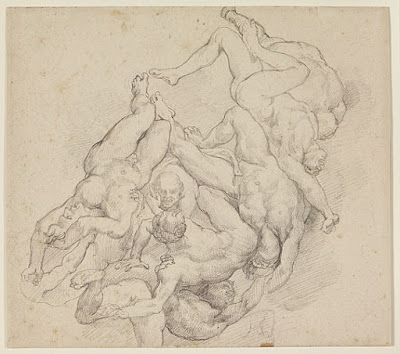-1966-oil-on-canvas-Museum-Ludwig-Cologne.jpg) |
| Gerhard Richter Ema (Nude on a Staircase) 1966 oil on canvas Museum Ludwig, Cologne |
-c1780-drawing-Yale-University-Art-Gallery.png) |
| attributed to Jean-Baptiste Regnault Perimele thrown from a Cliff by her father Hippodamus (scene from Ovid) ca. 1780 drawing Yale University Art Gallery |
 |
| Håkon Bleken Icarus 1971 drawing Nasjonalmuseet, Oslo |
-Mus%C3%A9e-des-Beaux-Arts-de-Valenciennes.jpg) |
| Alexandre-Denis Abel de Pujol Figure of Ignorance 1819 drawing (study for ceiling painting, Renaissance of the Arts) Musée des Beaux-Arts de Valenciennes |
 |
| Fernand Léger The Divers 1945 oil on canvas Kunsthalle Mannheim |
 |
| Anonymous Italian Artist Falling Youth ca. 1575-1600 drawing Princeton University Art Museum |
-1839-oil-on-canvas-Mus%C3%A9e-Ingres-Bourdelle-Montauban.jpg) |
| Théodore Chassériau Study of the model Joseph (also employed by Géricault for Raft of the Medusa) 1839 oil on canvas Musée Ingres-Bourdelle, Montauban |
-Moderna-Museet-Stockholm.jpeg) |
| Lennart Forsberg Severe Thunderstorm ca. 1970 linocut (book illustration) Moderna Museet, Stockholm |
 |
| Harold Edgerton Water flowing from Faucet ca. 1950 gelatin silver print Moderna Museet, Stockholm |
-c1890-cyanotype-Moderna-Museet-Stockholm.jpeg) |
| Carl Curman Untitled (Waterfall) ca. 1890 cyanotype Moderna Museet, Stockholm |
 |
| Hans Thoma Falls of the Rhine at Schaffhausen 1876 oil on canvas Kunsthalle Bremen |
 |
| Aelbert Cuyp Conversion of Saul ca. 1645-48 oil on panel Dordrechts Museum |
 |
| Jacob Philipp Hackert Eruption of Vesuvius 1774 oil on canvas Museumslandschaft Hessen Kassel |
 |
| Anonymous Italian Artist Fall of Phaeton ca. 1700 drawing Cincinnati Art Museum, Ohio |
 |
| Théodore Géricault Fall of the Rebel Angels ca. 1818 drawing Cantor Arts Center, Stanford University |
 |
| Edmund Joseph Sullivan Icarus 1906 drawing Auckland Art Gallery, New Zealand |
"Different nations make different claims about Homer's origins, my friend, and it may be true that the wise man is a native of every city. But the fact of the matter is that Homer was a compatriot of mine, an Egyptian, and his hometown was Thebes, 'Thebes of the hundred gates,' to borrow his own phrase. Ostensibly he was the son of a high priest, but in actual fact his father was Hermes, whose high priest his ostensible father was: for once when his wife was sleeping in the temple in the performance of some traditional rite, the god coupled with her and sired Homer, who bore on his person a token of this union of human and divine, for, from the moment of his birth, one of his thighs was covered with a shaggy growth of hair. Hence, as he begged his way around the world, particularly through Greece, performing his poetry, he was given the name ho meros, 'the thigh.' He himself never spoke his true name, never mentioned his city or his origins, but the name Homer was coined by those who knew of his physical deformity."
– Heliodorus, from The Aethiopica, or, Theagenes and Charikleia (3rd or 4th century AD), translated from Greek by J.R. Morgan (1989)